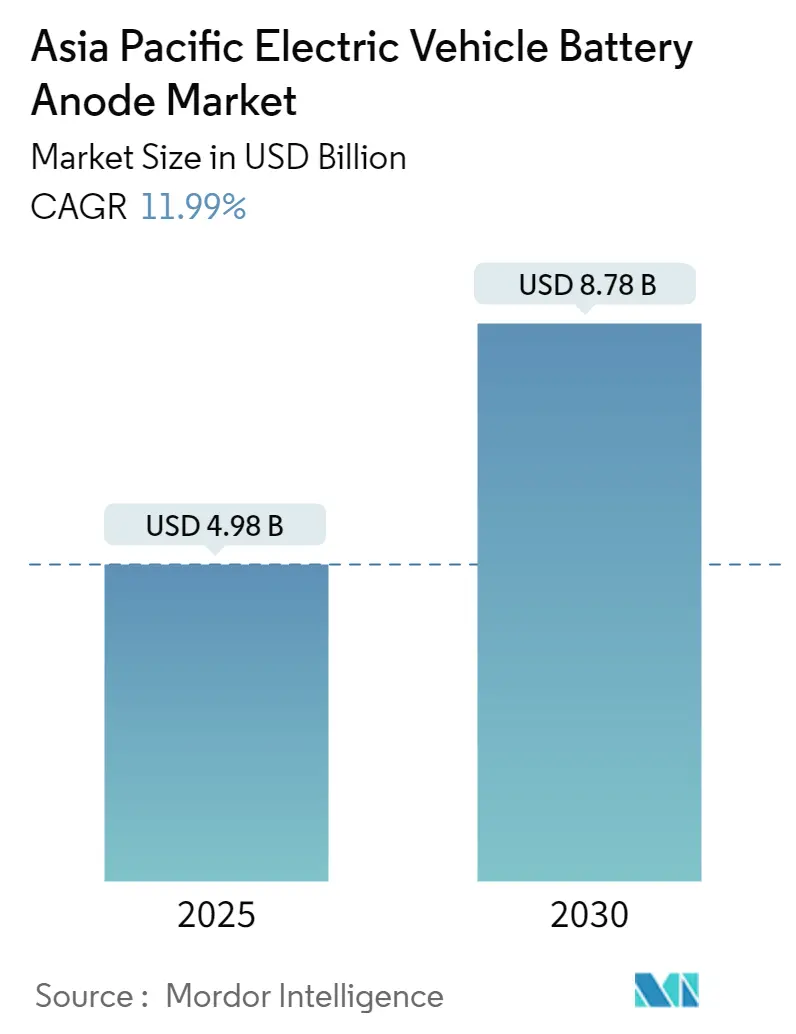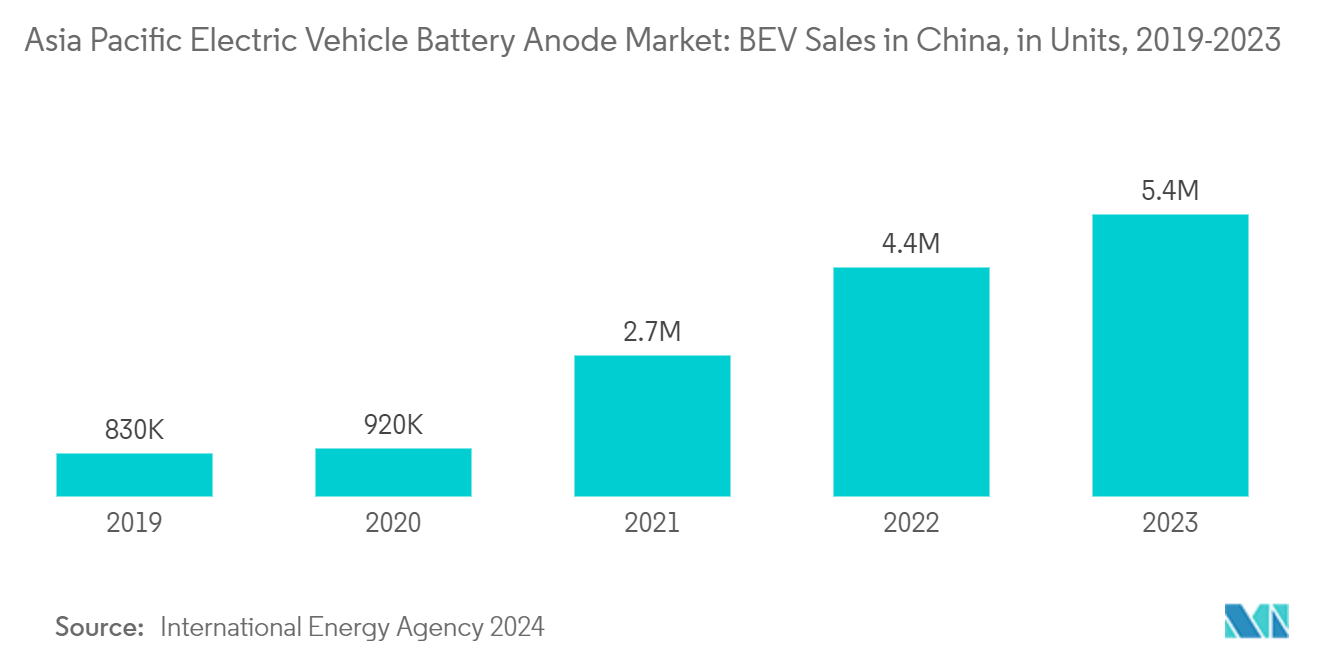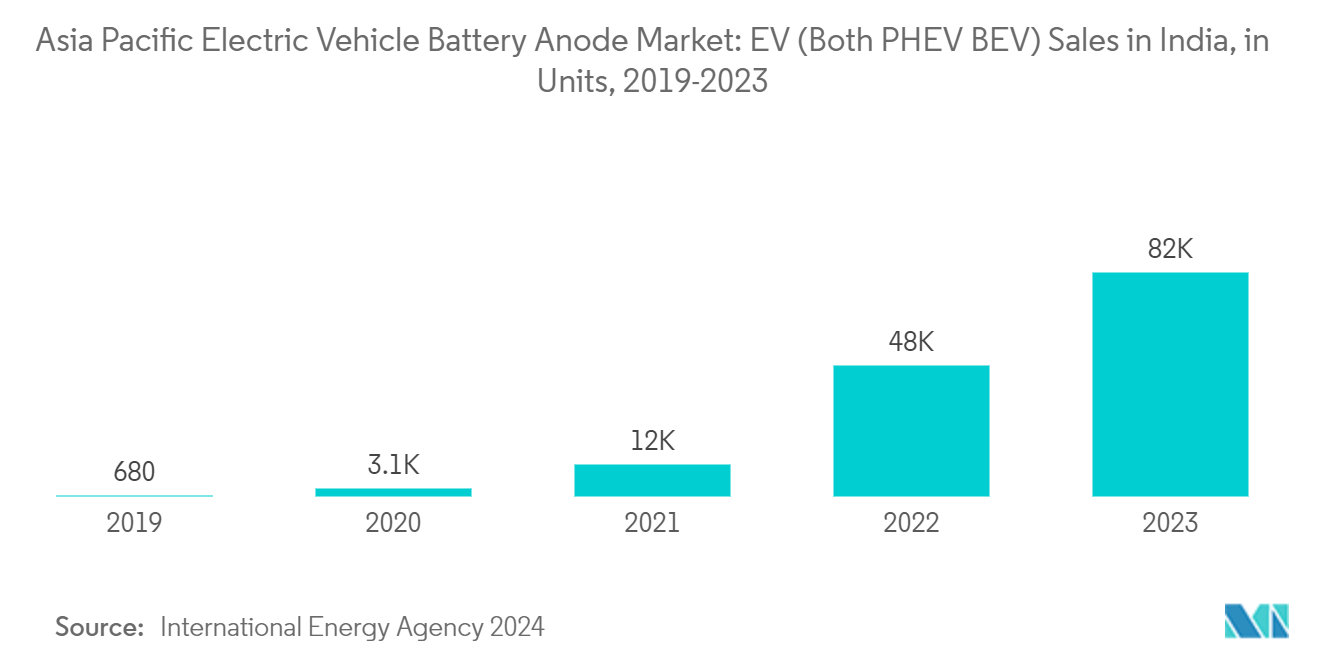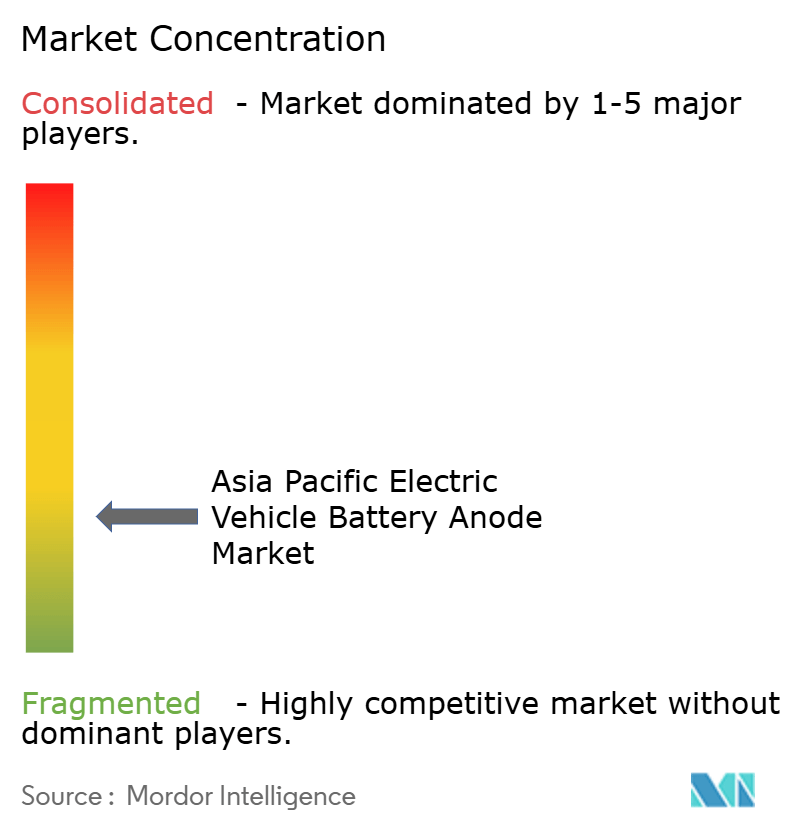Asia Pacific Electric Vehicle Battery Anode Market Size and Share

Asia Pacific Electric Vehicle Battery Anode Market Analysis by Mordor Intelligence
The Asia Pacific Electric Vehicle Battery Anode Market size is estimated at USD 4.98 billion in 2025, and is expected to reach USD 8.78 billion by 2030, at a CAGR of 11.99% during the forecast period (2025-2030).
- In the coming years, the Asia Pacific Electric Vehicle Battery Anode Market is poised for growth, driven by factors such as the rising adoption of electric vehicles, decreasing costs of battery raw materials (leading to lower prices for Li-ion batteries), and supportive government policies.
- Conversely, challenges like limited raw material reserves and gaps in the supply chain may hinder the market's expansion.
- However, advancements in battery anode technologies and ambitious long-term electric vehicle targets present significant opportunities for market players.
- Among the key players in the Asia-Pacific region, India stands out as a country poised for notable growth in the electric vehicle battery anode market.
Asia Pacific Electric Vehicle Battery Anode Market Trends and Insights
Lithium-ion Battery Segment to Dominate the Market
- In the early decades of the lithium-ion battery industry, the primary market for lithium batteries was consumer electronics. However, over the years, a notable shift took place. Electric vehicle (EV) manufacturers emerged as the leading consumers of lithium-ion batteries, driven by surging EV sales in the Asia-Pacific region.
- Over the past decade, the Asia-Pacific has seen a meteoric rise in the adoption of lithium-ion batteries, especially in the automotive sector. Countries like China, India, Japan, and Indonesia are increasingly favoring lithium-ion rechargeable batteries due to their superior capacity-to-weight ratio. Moreover, lithium batteries used in EVs do not emit NOX, CO2, or other greenhouse gases, resulting in a significantly lower environmental impact compared to traditional internal combustion engine (ICE) vehicles. Recognizing this advantage, numerous countries are promoting EV adoption and fostering the development of the Electric Vehicle Battery anode Market through subsidies and government initiatives.
- In May 2023, Himadri Speciality Chemical Ltd., a prominent player in the EV Battery Cathode and Anode market, announced a strategic investment of AUD 10.32 million in Sicona Battery Technologies Pty Ltd, securing a 12.79 percent stake. Sicona, based in Sydney, offers technology crucial for the anodes (negative electrodes) of lithium-ion (Li-ion) batteries, serving both the mobility sector and renewable energy storage.
- As electric vehicle adoption continues to rise, the lithium-ion battery cathode market is poised for substantial growth. Additionally, advancements in anode technologies are set to further propel this market expansion.
- According to the International Energy Agency (IEA), battery electric vehicle sales in China hit 5.4 million in 2023, with over 95% relying on Li-ion battery technology, marking a 22.7% increase from the previous year. Given this robust growth in the battery electric vehicle sector, lithium-ion batteries, with their distinct advantages, are projected to capture a significant share of the Asia-Pacific Electric Vehicle Battery Anode Market.
- In August 2024, BTR New Material Group inaugurated its new anode materials plant for lithium-ion batteries in Indonesia. The company claims that, once fully expanded, this facility will be the largest anode production site outside of China. The first construction phase, supported by a USD 478 million investment, is designed for an annual production capacity of 80,000 tons of anode material. A second phase, commencing at the end of 2024 with an additional USD 299 million investment, aims to diversify the facility's output, supplying anode materials for electric vehicles, appliance batteries, and energy storage systems. Such strategic moves underscore the growing dominance of EV Li-ion batteries in the Asia-Pacific EV Battery Anode Market.
- Given these advancements in the lithium-ion battery sector, the market for anode materials in the Asia-Pacific region's electric vehicle battery market is set for significant growth in the coming years.

India to Dominate the Market in Asia Pacific
- As part of the Paris Agreement and the United Nations SDGs, the Government of India has committed to reducing GHG emissions on global platforms. To bolster the adoption of Electric Vehicles (EVs) and position India as a global hub for EV battery manufacturing, the government has introduced rebates, incentives, and import concessions for players in the electric vehicle batteries and associated anode markets.
- On March 15, 2024, the Indian government approved the Scheme for Manufacturing of Electric Cars (SMEC). This initiative offers concessional import duties to automakers establishing new greenfield electric vehicle manufacturing plants. Under the scheme, manufacturers can import up to 8,000 EVs annually at a reduced duty of 15% for five years. This concession is granted on the condition that they establish domestic production capabilities within three years of receiving approval. Consequently, these developments are bolstering the rise of Li-ion battery technology for EVs, directly fueling the growth of anode materials in India.
- Given its vast potential and robust government backing, India is emerging as a prime manufacturing hub for companies eyeing the electric vehicle market. For instance, in September 2024, Epsilon Advanced Materials announced plans to set up two plants, each boasting a capacity of 30,000 tonnes per annum—one in the United States and the other in India. These facilities are poised to be the largest producers of anode material outside of China, marking India's debut as a large-scale supplier of electric vehicle battery anode material.
- In September 2024, Epsilon Advanced Materials, a key player in battery materials, disclosed its intent to set up another cutting-edge EV battery anode material manufacturing unit in Karnataka. With a projected investment of INR 9,000 crore (~USD 10.6 billion), the facility targets an annual production capacity of 90,000 tonnes. The investment strategy unfolds in two phases: an initial INR 4,000 crore (~USD 4.7 billion) infusion, followed by an additional INR 5,000 crore (~USD 5.9 billion) in the second phase, as detailed by Epsilon Group's Managing Director.
- In January 2024, the Advanced Carbons Company (TACC), a HEG Limited subsidiary and part of the LNJ Bhilwara group, launched its graphite anode manufacturing unit in Sirsoda village, Dewas district, Madhya Pradesh. The company had earmarked approximately INR 1850 crores (~USD 2.1 billion) for this greenfield project back in 2022. Spread over 100 acres, the facility is poised to churn out 20,000 metric tonnes of anode material annually, meeting the surging demands of energy storage and mobility.
- In 2023, the Government of India noted a significant 13% drop in average battery pack prices for electric vehicles (EVs), bringing them down to USD 139/kWh from the previous year. With ongoing technological advancements and enhanced manufacturing efficiencies, projections indicate a further decline in battery pack prices, forecasting USD 113/kWh by 2025 and an ambitious drop to USD 80/kWh by 2030. Such trends underscore the growing significance of the Lithium-ion Electric Vehicle Battery Anode Market in India.
- Given these developments, India is poised to emerge as a dominant player in the studied market in the coming years.

Competitive Landscape
The Asia Pacific Electric Vehicle Battery Anode Market is moderately fragmented. Some of the major players in the market (in no particular order) include BTR New Material Group Co., Ltd., Himadri Speciality Chemical Ltd., Hitachi Chemical Company Ltd, Panasonic Holdings Corporation, and Epsilon Advanced Materials Pvt. Ltd., among others.
Asia Pacific Electric Vehicle Battery Anode Industry Leaders
BTR New Material Group Co., Ltd.
Himadri Speciality Chemical Ltd.
Panasonic Holdings Corporation
Epsilon Advanced Materials Pvt. Ltd.
Hitachi Chemical Company Ltd
- *Disclaimer: Major Players sorted in no particular order

Recent Industry Developments
- October 2024: Rain Carbon and Northern Graphite have forged a partnership to collaboratively develop a natural graphite battery anode material (BAM) tailored for lithium-ion batteries in electric vehicles (EVs).
- August 2024: BTR New Material Group has commenced operations at its newly established anode materials plant for lithium-ion batteries in Indonesia. The company asserts that, once fully expanded, this facility will emerge as the largest anode production site outside of China. The initial construction phase, bolstered by a USD 478 million investment, boasts an annual production capacity of 80,000 tons of anode material. This Indonesian facility is poised to cater to a diverse range of applications, supplying anode materials for electric vehicles, appliance batteries, and energy storage systems. These developments further cement the dominance of EV Li-ion batteries in the EV Battery anode market throughout the Asia-Pacific region.
Asia Pacific Electric Vehicle Battery Anode Market Report Scope
An electric vehicle (EV) battery anode is a key component in lithium-ion and other rechargeable battery types used in EVs. The anode is the negative electrode within the battery, where lithium ions are stored during charging and released during discharging, thus providing the required electric motive power. It plays a critical role in determining the EV battery's energy capacity, lifespan, efficiency, and safety.
The Asia Pacific Electric Vehicle Battery Anode Market is Segmented by Battery Technology Type, Material Type, and Geography. By Battery Technology Type, the market is segmented into Lithium-Ion, Lead-Acid, and Other Technologies. By Material Type, the market is segmented into Silicon, Graphite, Lithium, and Other Materials, and by Geography, the market is segmented into China, India, Japan, Indonesia, Malaysia, Vietnam, Thailand, and the Rest of Asia-Pacific.
The report offers the market size and forecasts in revenue (USD) for all the above segments.
| Lithium-ion |
| Lead-acid |
| Other Technologies |
| Silicon |
| Graphite |
| Lithium |
| Other Materials |
| China |
| India |
| Japan |
| Malaysia |
| Indonesia |
| Thailand |
| Vietnam |
| Rest of Asia Pacific |
| By Battery type | Lithium-ion |
| Lead-acid | |
| Other Technologies | |
| By Material Type | Silicon |
| Graphite | |
| Lithium | |
| Other Materials | |
| Geography | China |
| India | |
| Japan | |
| Malaysia | |
| Indonesia | |
| Thailand | |
| Vietnam | |
| Rest of Asia Pacific |
Key Questions Answered in the Report
How big is the Asia Pacific Electric Vehicle Battery Anode Market?
The Asia Pacific Electric Vehicle Battery Anode Market size is expected to reach USD 4.98 billion in 2025 and grow at a CAGR of 11.99% to reach USD 8.78 billion by 2030.
What is the current Asia Pacific Electric Vehicle Battery Anode Market size?
In 2025, the Asia Pacific Electric Vehicle Battery Anode Market size is expected to reach USD 4.98 billion.
Who are the key players in Asia Pacific Electric Vehicle Battery Anode Market?
BTR New Material Group Co., Ltd., Himadri Speciality Chemical Ltd., Panasonic Holdings Corporation, Epsilon Advanced Materials Pvt. Ltd. and Hitachi Chemical Company Ltd are the major companies operating in the Asia Pacific Electric Vehicle Battery Anode Market.
What years does this Asia Pacific Electric Vehicle Battery Anode Market cover, and what was the market size in 2024?
In 2024, the Asia Pacific Electric Vehicle Battery Anode Market size was estimated at USD 4.38 billion. The report covers the Asia Pacific Electric Vehicle Battery Anode Market historical market size for years: 2019, 2020, 2021, 2022, 2023 and 2024. The report also forecasts the Asia Pacific Electric Vehicle Battery Anode Market size for years: 2025, 2026, 2027, 2028, 2029 and 2030.
Page last updated on:
Asia Pacific Electric Vehicle Battery Anode Market Report
Statistics for the 2025 Asia Pacific Electric Vehicle Battery Anode market share, size and revenue growth rate, created by Mordor Intelligence™ Industry Reports. Asia Pacific Electric Vehicle Battery Anode analysis includes a market forecast outlook for 2025 to 2030 and historical overview. Get a sample of this industry analysis as a free report PDF download.



